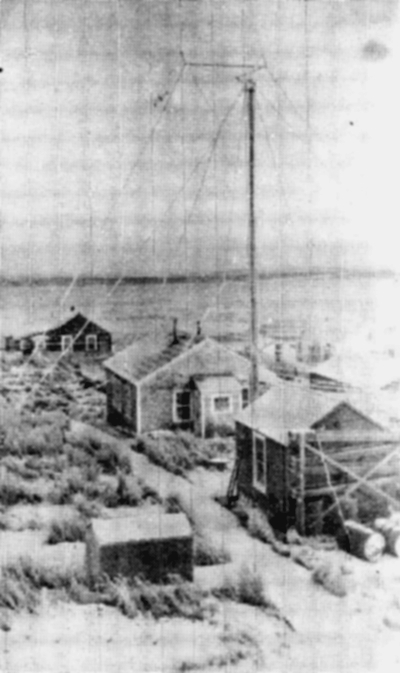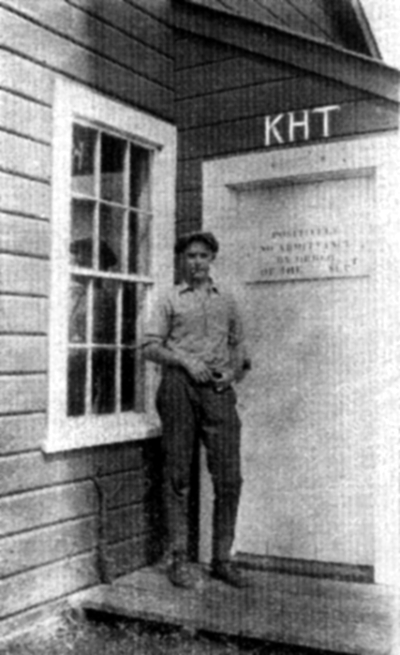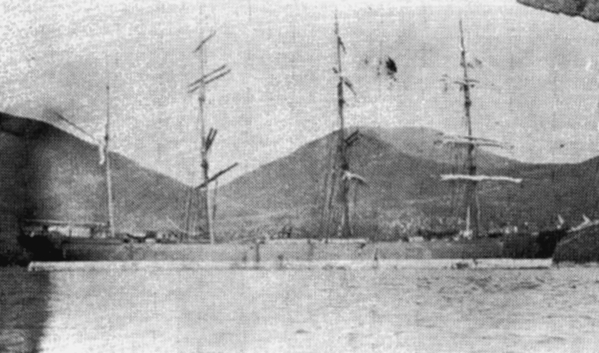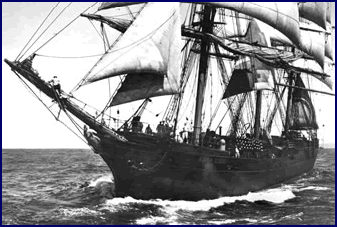|
Bristol Bay - 1924
By - EARL W. KORF - 613-P From "Sparks"
Volume 1 - Number 2, Spring - 1974
This story is about the Alaska Packers Assn. (APA) in 1924. This company had the largest sailing ship fleet in existence at the time, including such windjammers as the Stars of Alaska; Scotland; France; India; Italy; Lapland; Scotland and New Zealand. This was the last year that many of these grand old ships saw service. I was 19, green and only sea experience was a 9day trip from Frisco to Pedro and back on the Red Stack tugboat Sea Ranger (KDSQ). Mr. Gaskey of the APA assigned me to the STAR OF ITALY, a three masted full rigged ship, radio call of ICPFI. As the company had labor troubles this spring, the fleet was delayed in sailing, which put us about 3 weeks late. As a result of the late getaway, most of the fleet was towed to about 600 miles straight west of San Francisco where we could pick up the westerly winds. We left Frisco May 8th and it took us 28 days to reach Naknek in Bristol Bay. These sailing ships were equipped with navy submarine quenched spark quarter kw transmitters and honeycomb coil receivers. Power was furnished by a Delco plant with storage batteries. These Delco engines were not the best in a heavy rolling ship. Roll heavily to one side and the gas feed would cut off. I spent much of my time, keeping this darn engine going so as to keep the batteries charged. Could not receive when the engine was running due to heavy induction noise. But it did the job. When 50 miles off the Aleutian Islands, we became becalmed for a week. Only nice thing about this was that we were becalmed over some very fine cod and halibut fishing grounds. Everybody fished and every day caught much more than we needed. When we finally got out of our calm with a westerly gale we didn't
lose any time. When transiting Unimak Pass from the Pacific into
the Bering Sea, we overtook the SS Cadaretta which was rolling heavily
and making only about 7 or 8 knots with a beam wind and sea, while
we were shooting along about 12 knots with all sails full. We passed
him by at a distance of only about a hundred yards. Don't imagine
the crew of the steamer was too happy with the sight. This was last year of such a large assembly of sailing ships. Thereafter they kept dwindling down each year as more steamers took their places and in 1928 when I again returned to Bristol Bay, only three sailing ships were there and two of them were cod fishing schooners with aux power. I stayed aboard the ship at anchor for 8 days until the ship was unloaded. The canneries were located inside the rivers, Naknek and Kvichak rivers and cargo transported back and forth in lighters, towed by small tugs. When ship was unloaded, everyone went ashore except the Captain who usually stayed aboard ship as watchman. Some times, the mate would remain aboard when the skipper went ashore to run some of the tug boats.
We were about 8 miles from our land station KHT and many times communicated with KHT from the ship with the receiver only. Those honey comb coils were great for regeneration. Just get them to squeal and break the antennae and key it. Worked good when not much qrm and saved the batteries. When ship was unloaded, we went ashore and assisted in operating the main APA station KHT at Naknek. Also prepared the wireless equipment for the bunk scows. We were not too busy as the station was overmanned. Some oprs went to other APA stations in Koggiung, Egegik, Ugashik, and Nushagak. Naknek was the main base and the main wireless station. We would collect all wireless reports from the other company stations in and around Bristol Bay then with our 2 kw spark, would route our traffic to the states through navy stations at Kodiak, Anchorage, or Army station at Kanakanak (Nushagak). During these 3 weeks before fishing season started, the canneries were busy repairing and overhauling the canning machinery. Fishermen busy in repairing and getting their boats in readiness and work to be done on tow boats, lighters and what have you. The Canneries were busy places. Fishing season was for the month of July. Fishing not allowed inside the rivers so the small fishing boats, using gill nets, caught their fish out in the bay and discharged them into lighters, which were tied up to bunk scows, which were moored several miles off shore. Each company had their own bunk scows. I was assigned to the bunk scow Ruby. Forgot my call letters but we were equipped with a ten-inch spark coil transmitter with crystal detector. Only had to transmit about 7 or 8 miles. We were moored half way between the mouths of the Naknek and Kvichak rivers. As the tides are very high in Bristol Bay, all boat work has to be calculated upon the tides, as at low water no boats could wallow through the mud to the cannery wharfs. For this reason, the bunk scows were moored outside to save time for the fishermen. They could discharge their fish to us, get a good mean and be back on the fishing grounds in a few minutes to get another catch. Our scow was manned with a Captain, 2 cooks and a helper and two tallymen to count fish. I was one of the tallymen. I think they paid us a few extra bucks for this work, although the wireless didn't take up much of my time. We on the bunk scow were out in the bay for the entire month which was not always too pleasant, especially in bad blows. But the work was exciting and interesting. We also had extra bunks for any fishermen who were in need of rest. When the fish were running good, they never took time out to rest. Get a boat load of several hundred to a thousand salmon, sail to the scow, unload into the lighter, tied behind the scow, grab a quick meal on the scow and right back for another load of fish, 24 hours a day. These Portuguese and Italian fishermen were rugged men. Their fishing Prams were not powered either. Only sail. When our lighters would be close to being filled, we would wireless in to KHT, tell them how many fish we had and they would pick them up with a tow boat and get them to the cannery on the next high tide. At low water, we were sitting on the mud and at high water, we were floating in 28 feet of water. What tides. Believe they are the highest, next to the Bay of Fundy 50 foot tides. We tallymen were being continuously tempted to write in the fishermen's books, a greater number of fish than they had as they were getting paid so much a fish. We had offers of whisky (Moonshine) wine and cash. Suppose some tallymen did make a fortune at it, altho our captain was pretty strict so we had to settle for an occasional bottle of wine. Dog salmon did not pay hardly anything at that time as no one would eat the pink salmon. The fishermen would never tell us about the dog salmon they were trying to pawn off on us as they spewed them into the lighter. It was up to us to notice if it was a dog or sockeye or what. Took some experience to tell the difference. During these 30 days we saw very little meat but our cooks were so good 'that we could eat salmon three times a day and it tasted different each time. Quite often we would get a halibut or salmon trout for delicacies. When the fishing season was over, we came back to Naknek station and worked there for a week before we boarded our ships when the loading commenced.
During the fishing season, the Captain of the bark STAR OF LAPLAND shot and killed himself. Capt. Weiderstorm who was assigned to take over the LAPLAND, stayed aboard only a week. He wouldn't go near the captain's cabin where the suicide occurred and definitely refused to take her home. So Captain Sparr volunteered to sail the bark home. The Bristol Bay catch was very light that year and they couldn't fill up the LAPLAND's holds and the catch at Larsens Bay on Kodiak Island was heavy so the LAPLAND was rerouted to Larsens Bay which would delay its arrival in SF. As the LAPLAND's wireless opr wanted to get home as soon as possible, I traded with him. I wanted to see as much of Alaska as possible as I thought I would never get back. This STAR OF LAPLAND/KXOA was some wind-jammer. A 4-masted bark which was the largest sailing ship under the American flag at the time. It was previously the ATLAS which had made some record runs between California and China.
We sailed from Naknek early in August for Larsens Bay on northwest part of Kodiak. After transiting Unimak Pass we headed northeast for Kodiak, paralleling the Aleutian chain. We picked up a westerly gale with heavy seas and rain, but being a fair wind, we really flew. Trouble was that we didn't see the sun for two days and the skipper couldn't get any position sights. No df stations along there at that time. We had to pass through Chirikof Straits which was only about 8 miles wide. Had nothing but dr since passing through the Unimak Pass, 500 miles back. Here we were doing somewhere around 15 knots with a 60-mile gale, heavy seas and visibility of about a half a mile, trying to needle through an 8-mile passage. I would have pulled in most of the sails to slow her down but I was definitely not the Captain. Anyway, all, of a sudden, the forward lookout hollered out the famous words "Breakers dead ahead." Boy, I never saw such activity in such speed. Wheel had to be turned over, of course, but at same time, the sails had to be trimmed. Everyone including myself got on those yards and we went past those rocky cliffs at a mile a minute. Almost could have jumped to the closest rock. What a relief. Anyway, we made Larsens Bay and spent a week there loading. On our trip on down to Frisco again we caught a westerly gale of fair winds and made it to off the coast of Cape Mendocino in record time. If we hadn't run out of wind near the coast, it would have been a record run of 12 days. For two days we were becalmed off the coast and finally had to call for a tow on into Alameda. On the beach for two weeks in Frisco, then assignment to the big palatial liner, ROSE CITY, HI. So this ends the 1924 Alaska story. I did go back to KHT in spring of '28 for a 30 months exciting stay but that's another story. Earl W. Korf - 613-P (K2IC) This web version © John Dilks, K2TQN, February 10, 2003. |



